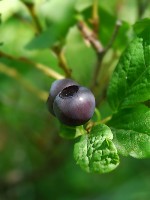Mon-Fri 9am - 5pm Mountain time
Mountain Huckleberry vs Grouseberry
Vaccinium scoparium
Vaccinium membranaceum
CUSTOM GROW
NOT AVAILABLE THIS SEASON - MIGHT RETURN
Grouseberry is a native, low-growing deciduous shrub known for its edible red berries. In early summer, it produces small, urn-shaped flowers ranging from white to pink that attract bees and other pollinators. The berries provide an important food source for many types of wildlife, including game birds such as grouse, which gives the plant its common name. People can also enjoy the berries fresh or in baked goods, though they can be difficult to harvest in large quantities.
Spreading by rhizomes, Grouseberry forms dense, broom-like mats that help stabilize soil and prevent erosion, while also providing cover for ground-nesting wildlife. It is commonly found beneath conifers in open forests, subalpine meadows, and occasionally on rocky slopes in mountainous regions. It is well-suited for naturalization, ecological restoration, and soil stabilization projects.
Mountain Huckleberry is a small shrub known for its tart to sweet berries. The berries range from purple-black to red-black, and can be eaten fresh or used in jams and syrups. It is a plant native to Alberta and the berries are frequently enjoyed by both people and wildlife.
In traditional Indigenous fire management practices, berry patches were burned after harvest. This would reduce the invasion of other plants allowing the Mountain Huckleberry to thrive. Its foliage has low flammability and can survive low severity fires, and even if destroyed they regrow from the roots.
Note: Mountain Huckleberry requires specific soil conditions. They need moist, well-drained, acidic soil with a pH around 5.5.

